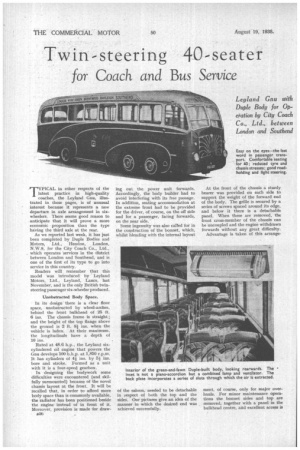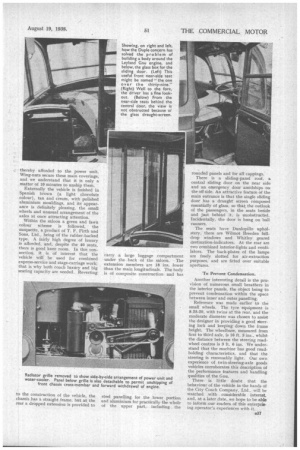Twin-steering 40-seater
Page 46

Page 47

If you've noticed an error in this article please click here to report it so we can fix it.
for Coach and Bus Service
Leyland Gnu with Duple Body for Operation by City Coach Co., Ltd., between London and Southend
PICAL in other respects of the latest practice in high-quality coaches, the Leyland Gnu, illustrated in these pages, is of unusual interest because it represents a new departure in axle arrangement in sixwheelers. There seems good reason to anticipate that it will prove a more economic proposition than the type having the third axle at the rear.
As we reported last week, it has just been completed by Duple Bodies and Motors, Ltd., Hendon, London, N.W.9, for the City Coach Co., Ltd., which operates 'services in the district between London and Southend, and is one of the first of its type to go into service in this country.
Readers will remember that this model was introduced by Leyland Motors, Ltd., Leyland, Lanes, last November, and is the only British twinsteering passenger six-wheeler produced.
Unobstructed Body Space.
In its design there is a clear floor space, unobstructed by wheel-arches, behind the front bulkhead of 25 ft. 6 ins. The chassis frame is straight; and the height of the top flange above the ground is 2 ft. 84 ins, when the vehicle is laden. At their maximum, the longitudinals have a depth of 10 ins.
Rated at 48.6 li.p., the Leyland sixcylindered oil engine that powers the Gnu develops 100 b.h.p. at 1,850 r.p.m. It has cylinders of 44 ins. by 54 ins. bore and stroke. Formed as a unit with it is a four-speed gearbox.
In designing the bodywork some difficulties were encountered (and skilfully surmounted) because of the novel chassis layout at the front. It will be recalled that, in order to afford more body space than is commonly available, the radiator has been positioned beside the engine instead of in front of it. Moreover, provision is made for draw
silts
luging out the power unit forwards. Accordingly, the body builder had to avoid interfering with its free passage. In addition, seating accommodation at the extreme front had to be provided for the driver, of course, on the off side and for a passenger, facing forwards, on the near side.
Some ingenuity was also called for in the construction of the bonnet, which, whilst blending with the internal layout
of the saloon, needed to be detachable in respect of both the top and the sides. Our pictures give an idea of the manner in which the desired end was achieved successfully.
At the front of the chassis a sturdy bearer was provided on each side to support the weight of the forward end of the body. The grille is secured by a series of screws spaced around its edge, and below it there is a detachable panel. When these are removed, the front cross-member of the chassis can•be uncoupled and the engine withdrawn forwards without any great difficulty. Advantage is taken of this arrange assent, of course, only for major overhauls. For minor maintenance operations the bonnet sides and top are removed, together with a panel in the bulkhead centre, and excellent access is
thereby afforded to the power unit. Wing-nuts secure these main coverings, and we understand that it is only a matter of 10 minutes to unship them.
Externally the vehicle is finished in Spanish brown (a light chocolate colour), tan and cream, with polished aluminium mouldings, and its appearance is definitely pleasing, the small wheels and unusual arrangement of the axles at once attracting attention.
Within the saloon a green and fawn colour scheme is followed, the moquette, a product of T. F. Firth and Sons, Ltd., being of the rubber-backed type. A fairly high degree of luxury is afforded, and, despite the 40 seats, there is good knee room. In this connection, it is of interest that the vehicle. will be used for combined express-service and stage-carriage work; that is why both coach luxury and big seating capacity are needed. Reverting
to the construction of the vehicle, the chassis has a straight frame, but at the rear a dropped extension is provided to carry a large luggage compartment under the back of the saloon. The extension members are 18 ins, lower than the main Iongitudinals. The body is of composite construction and has
steel panelling for the lower portion and aluminium for practically the whole of the upper part, including the
rounded panels and for all cappings; There is a sliding-panel roof, a central sliding door on the near side and an emergency door amidships on the off side. An attractive feature of the main entrance is that the single sliding door has a draught screen composed essentially of glass, so that the outlook of the passengers, in the seats beside and just behind it, is unobstructed. Incidentally, the door is hung on ball runners.
The seats have Dunlopillo upholstery, there are Wilmot Breeden fulldrop windows and Whitley geared destination-indicators. At the rear are two combined interior-lights and ventilators. The back-plates of the lamps arc freely slotted for air-extraction purposes, and are fitted over suitable apertures, 'To Prevent Condensation.
Another interesting detail is the provision of numerous small breathers in the interior panels, the object being to prevent Condensation within the space between inner and outer panelling.
Reference was made earlier to the small wheels. The tyre equipment is 8.25-20, with twins at the rear, and the moderate diameter was chosen to assist the designer in providing a good steering lock and keeping down the frame height. The wheelbase, measured from first to third axle, is 16 ft. 3 ins., whilst the distance between the steering roadwheel centres is 3 ft. 6 ins. We understand that the machine has good roadholding characteristics, and that the steering is reasonably light. Our own experience of twin-steering-axle goods vehicles corroborates this description of the performance features and handling qualities of the Gnu.
There is little doubt that the behaviour of the vehicle in the hands of the City Coach Company, Ltd., will be watched with considerable interest, and, at a later date, we hope to be able to inform our readers of this enterprising operator's experiences with it.




















































































